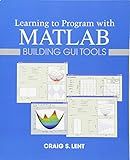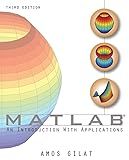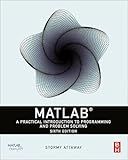Best MATLAB Matrix Tools to Buy in December 2025

Learning to Program with MATLAB: Building GUI Tools



MATLAB: An Introduction with Applications



Essential MATLAB for Engineers and Scientists



MATLAB: A Practical Introduction to Programming and Problem Solving



Essential MATLAB for Engineers and Scientists



MATLAB Numerical Methods with Chemical Engineering Applications
- AFFORDABLE PRICES FOR QUALITY BOOKS IN GOOD CONDITION.
- ECO-FRIENDLY CHOICE: PROMOTE RECYCLING BY BUYING USED BOOKS.
- DIVERSE SELECTION: DISCOVER UNIQUE TITLES AT GREAT SAVINGS!



Computer Methods for Engineering with MATLAB Applications (Computational and Physical Processes in Mechanics and Thermal Sciences)
- AFFORDABLE PRICES MAKE QUALITY READING ACCESSIBLE TO EVERYONE.
- SUSTAINABLY SOURCED: ECO-FRIENDLY OPTION FOR SAVVY SHOPPERS.
- THOROUGHLY VETTED FOR QUALITY: ENJOY GREAT READS WITH PEACE OF MIND.


To loop through elements in a matrix in MATLAB, you can use nested for loops. Here is an example code snippet that demonstrates this:
% Define a sample matrix matrix = [1 2 3; 4 5 6; 7 8 9];
% Get the size of the matrix [rows, cols] = size(matrix);
% Loop through each element using nested for loops for i = 1:rows for j = 1:cols % Access the element at row i and column j element = matrix(i, j);
% Perform desired operations on the element
% Display the element
disp(element);
end
end
In the above code, the for loops iterate over each row (i) and column (j) of the matrix. The current element at each iteration is accessed using indexing (matrix(i, j)). You can replace the disp(element) line with any operations or computations you want to perform on each element.
This approach allows you to traverse through all the elements in the matrix and perform specific tasks on them, such as modifying the values, calculating statistics, or applying algorithms.
How to access elements of a 3D matrix in MATLAB?
To access elements of a 3D matrix in MATLAB, you can use indexing operations similar to accessing elements in a 2D matrix, but with an extra dimension.
Here is an example to illustrate the indexing for a 3D matrix:
% Create a 3D matrix of size 3x4x2 matrix3D = randi(10, 3, 4, 2);
% Accessing a single element element = matrix3D(2, 3, 1); disp(element);
% Accessing a slice (2D matrix) along the third dimension slice = matrix3D(:, :, 2); disp(slice);
% Accessing a row along the first dimension row = matrix3D(1, :, :); disp(row);
% Accessing a column along the second dimension col = matrix3D(:, 2, :); disp(col);
In the above example, matrix3D(2, 3, 1) accesses the value at row 2, column 3, and the first layer of the 3D matrix.
Similarly, matrix3D(:, :, 2) accesses the second layer of the 3D matrix, resulting in a 2D matrix slice.
matrix3D(1, :, :) accesses the first row of the 3D matrix, resulting in a 2D matrix.
matrix3D(:, 2, :) accesses the second column of the 3D matrix, resulting in a column vector.
You can adjust the indexing operations according to your specific needs to access elements or sub-matrices from the 3D matrix.
What is a nested loop in MATLAB?
A nested loop in MATLAB is a loop that is contained inside another loop. It allows you to execute a set of statements repeatedly in a structured manner. The outer loop controls the overall iteration, while the inner loop repeats a specific set of statements multiple times within each iteration of the outer loop. The number of iterations of the inner loop is determined by the logic and condition provided in the loop structure. The nested loop structure allows for more complex and flexible programming in MATLAB.
What is the "end" keyword used for in MATLAB?
In MATLAB, the "end" keyword is used to represent the last index of an array or to end a loop or conditional statement.
- Indexing: When accessing elements of an array, "end" is used as a placeholder for the last index. For example, if you have a vector A = [1, 2, 3, 4], accessing the last element can be done using A(end).
- Looping: The "end" keyword is also used to indicate the end of a loop. For example, in a for loop, "end" is used to denote the completion of the loop iterations.
- Conditional statements: In if-else or switch-case statements, "end" is used to indicate the end of a block of code associated with a condition or case.
Here is an example usage of "end" in MATLAB:
A = [1, 2, 3, 4, 5]; for i = 1:numel(A) if A(i) > 2 disp("Greater than 2"); end end
In this example, "end" is used to indicate the end of the for loop and the if statement block.
